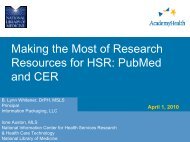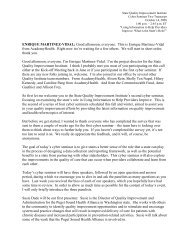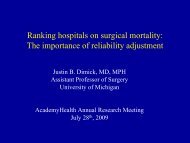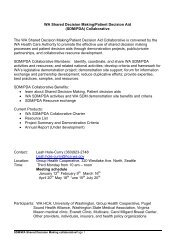Ohio Health Quality Improvement Plan
Ohio Health Quality Improvement Plan
Ohio Health Quality Improvement Plan
Create successful ePaper yourself
Turn your PDF publications into a flip-book with our unique Google optimized e-Paper software.
Appendix IV — Co m m e n t s f r o mStatewide Or g a n iz a t io n s40statewide children’s hospital collaborative (‘07). In2009, an initiative, “Solutions for Patient Safety” waslaunched with the support of Cardinal <strong>Health</strong>, the <strong>Ohio</strong>Business Round Table, 17 Central <strong>Ohio</strong> hospitals andeight children’s hospitals. This project will addressmedication errors and hospital-acquired infections.OHA also partners with The Joint Commission to helphospitals attain a level of continuous survey readinessfor accreditation surveys, and leads other state andlocal quality and patient safety initiatives.• The OHA Data Services Department has beenworking to develop web-based data submission andprocessing applications for hospital data, includinga comprehensive statewide information technologyexchange that allows data sharing among providers.The goal is to adopt data standards for healthinformation by the end of 2009, and to disperse thetechnology through existing collaborative purchasingmodels.OHA’s principles for health care reform directly touch thedecision point evaluating and choosing payment reformmodels. The system should be organized to meet the needsof the community and the individual patient, with a goalof customer value. The system should provide incentivesfor managing controllable costs, and should include:reliance on a balance of fair market forces and appropriategovernment regulations, a seamless delivery system to meetthe needs of the patient, a comprehensive system focusedon prevention and wellness, flexibility to meet the changingneeds of the purchaser/consumer, care in the most costeffective setting, a fair and balanced tort resolution process,and personal accountability. For more information on the<strong>Ohio</strong> Hospital Association’s vision, goals, and principlesfor health care reform, refer to http://www.ohanet.org/reform/default.htm.Thank you for the opportunity to be part of this process andto comment on the final report.<strong>Ohio</strong> Nurses AssociationAll health care should be center on the individual not uponthe profession providing the care. In this day and age weneed to stop protecting turf and start trying to provide theright care, at the right time that is affordable. Access tocare for all should be the driver for the future of health carewith the health care providers being adequately reimbursedfor provided service. Prevention should be started youngand practiced by all through the ages so that less health careservices are required and the quality of life is enhanced.<strong>Ohio</strong> Osteopathic AssociationThe <strong>Ohio</strong> Osteopathic Association is pleased to endorse thefour collaborative transformation strategies contained in the<strong>Ohio</strong> <strong>Health</strong> <strong>Quality</strong> <strong>Improvement</strong> <strong>Plan</strong>. <strong>Health</strong> promotionand disease prevention, health information technologyand payment reform using the Medical Home and Payfor Performance models are high priorities of the OOA.We are uniquely qualified to assist the state in these areasbecause:• According to The Physician Supply and DemandConsultation to the <strong>Ohio</strong> Board of Regents, publishedFebruary 27, 2007: “88% of direct patient carephysicians in <strong>Ohio</strong> are allopathic physicians (MD) and12% are osteopathic physicians (DOs). Osteopathicgraduates of <strong>Ohio</strong> medical schools [the <strong>Ohio</strong> UniversityCollege of Osteopathic Medicine] are more likely to bein direct patient care, primary care (36.7% vs. 43.6%),are more likely to practice in a rural area (10.8% vs16.0%), and more likely to be in a Primary Care <strong>Health</strong>Profession Shortage Area (7.1% vs. 9.9%)”• The American Osteopathic Association (AOA) wasone of the four physician organizations that developedJoint Principles of the Patient-Centered MedicalHome (March 2007). In addition, the AOA serveson the Executive Committee of the Patient CenteredPrimary Care Collaborative, a coalition of more than500 employers, consumer groups, patient qualityorganizations, health plans, labor unions, hospitals,physicians and others who have joined together todevelop and advance the patient centered medicalhome.• The AOA’s Clinical Assessment Program (CAP),developed under the leadership of George Thomas,DO, Cleveland, and Richard J. Snow, DO, Columbus,measures current clinical practices in the physician’soffice and compares the physician’s outcomes measuresto their peers using national evidence-based clinicalpractice standards. Measure sets include CoronaryArtery Disease, Diabetes Mellitus, and Women’s <strong>Health</strong>Screenings. CAP is among 32 medical registriesqualified to submit quality data to the Centers forMedicare and Medicaid Services (CMS) on behalf of










